Tropical Rainforest Biome
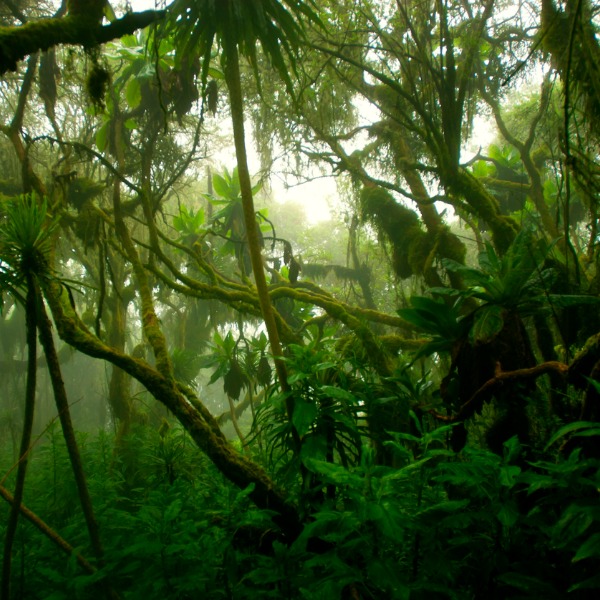
Dense tropical rainforest (guenterguni, iStockphoto)

Dense tropical rainforest (guenterguni, iStockphoto)
How does this align with my curriculum?
Learn about the location, plants, animals, human impacts and conservation of tropical rainforest biome.
The Terrestrial Biomes
The terrestrial world can be divided into areas called biomes. A biome is a large area of land classified by its plants and animals.
A biome is made up of many ecosystems. An ecosystem is the interaction of living and nonliving things in an environment.
Misconception Alert
An ecosystem is not the same thing as a biome. A biome is the specific geographic area in which ecosystems can be found.
In this backgrounder, major terrestrial biomes of the world are named based on the Whittaker classification scheme. This is not the only classification system because not all scientists agree on the number and types of biomes.
Distribution of the Earth’s Major Biomes
The map below shows where each of the eight major terrestrial biomes are located in the world. Canada contains four biomes. These are temperate deciduous forest, grassland, boreal forest/taiga, and tundra. A biome has the same characteristics no matter where in the world it is found. This means that the boreal forests of Canada look like the boreal forests of Russia.
The characteristics of each biome are dependent on its climate. Temperature and precipitation are the most important factors determining what living things can be found in a given biome.
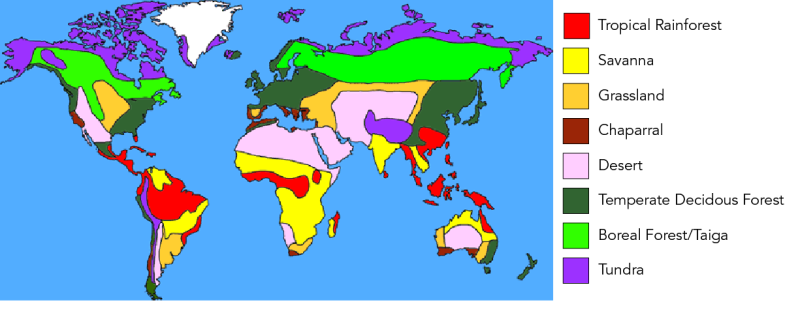
Image - Text Version
Shown is a colour world map illustrating the location of terrestrial biomes.
The map shows the world's oceans in blue, and its landmasses in stripes and blobs of eight different colours.
A legend on the right side identifies the biomes associated with each colour. Red is labelled "Tropical Rainforest." Yellow is labelled "Savanna." Gold is labelled "Grassland." Brown is labelled "Chaparral." Pink is labelled "Desert." Dark green is labelled "Temperate Deciduous Forest." Bright green is labelled "Boreal Forest/Taiga." Purple is labelled "Tundra."
Starting at the top, purple indicates Alaska, Canada's arctic, the tip of Greenland, Northern Russia, a strip close to the west coast of South America, and part of Central Asia, are tundra.
Below, most of southern Canada and Russia are bright green for boreal forest/taiga.
A gold blob in the middle of North America, another on the southeast coast of South America, a strip in an arc shape across part of the Middle East and southern Russia, a small part of the southeast coast of Africa, and small parts of the west and south coasts of Australia, indicate grassland.
Dark green appears on the west and east coasts of North America, the west coast of South America, large parts central and southern Europe, the UK, eastern Asia, the southeast corner of Australia, and all of New Zealand. This indicates temperate deciduous forest.
Pink areas are across the western United States, northern Mexico, a narrow strip of South America, most of North Africa and the tip of South Africa, Central Asia and the middle of Australia. These indicate desert.
The brown areas are small and scattered widely. They are along the southwest coast of the United States, the northeast coast and southern tip of Africa, most of Italy, Greece and Turkey, and small parts of southern Australia. These indicate chaparral.
Red is scattered across parts of the southern hemisphere. This includes Central America, northern parts of South America, a thin strip across most of Africa and the northern tip of Madagascar, most of Southeast Asia and the northeast tip of Australia. This indicates tropical rainforest.
Yellow is in two blobs in South America, most of the southern half of Africa, most of India, a small strip of Southeast Asia, and the northwest coast of Australia. This indicates savanna.
Tropical Rainforests
Location
Tropical rainforests are found in the equatorial zone in Central America, South America, Africa, Asia and Australia (see map above).
Description
Tropical rainforests have warm temperatures and high humidity. Humidity refers to how much water vapour in the air. Tropical rainforests typically receive between 1.5 m to 4 m of rainfall each year. That’s a lot of moisture! This warm, humid climate makes tropical rainforests a great habitat for plants and animals. Rainforests are one of the most biodiverse biomes on Earth.
Did you know?
As many as half of the Earth’s terrestrial species are found in this one biome!
Plants & Animals
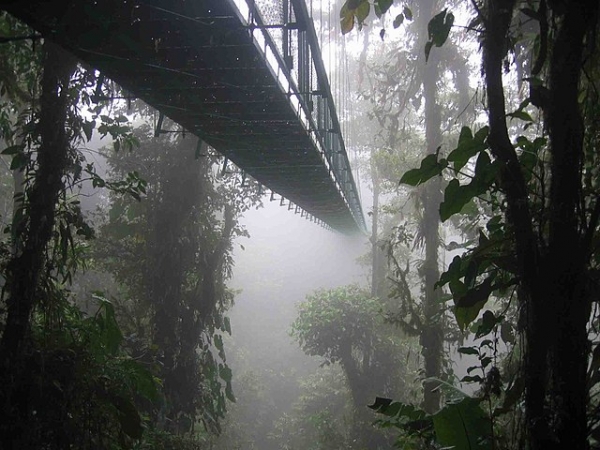
Image - Text Version
Shown is a colour photograph of an elevated walkway through trees.
The image is dark and thick with mist. Trees stretch from the bottom to the top. A walkway with railings is suspended far above the ground, among the treetops. It disappears into the mist in the distance.
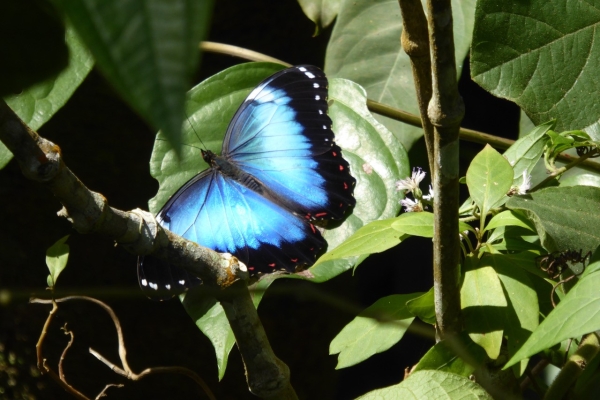
Image - Text Version
Shown is a colour photograph of a blue butterfly among green leaves.
The butterfly is in the centre of the image. Its wings are outspread, and bright blue with black edges. It is surrounded by thin green branches and wide green leaves. Sunlight shines through the leaves, creating shadows.

Image - Text Version
Shown is a colour photograph of a bright blue, spotted frog.
The frog is vibrant, electric blue. Its legs and underside are a deep, saturated shade. Its back is bright and sprinkled with dark spots of various sizes.
The landscape around is muted in comparison. A beige boulder, a few green leaves and a log, glistening with water.
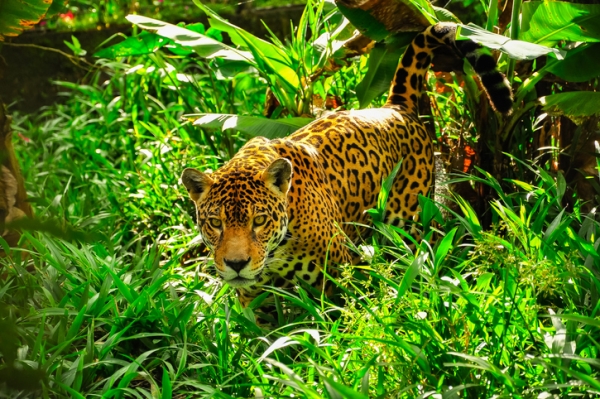
Image - Text Version
Shown is a colour photograph of a large cat in thick, leafy plants.
The cat is staring at something below and to the left of the camera. It is gold, with gold eyes. Its fur is marked with black spots and uneven circular patterns. The leaves around it are bright green with dappled sunlight. The cat is a different colour than its surroundings, but it does not stand out.
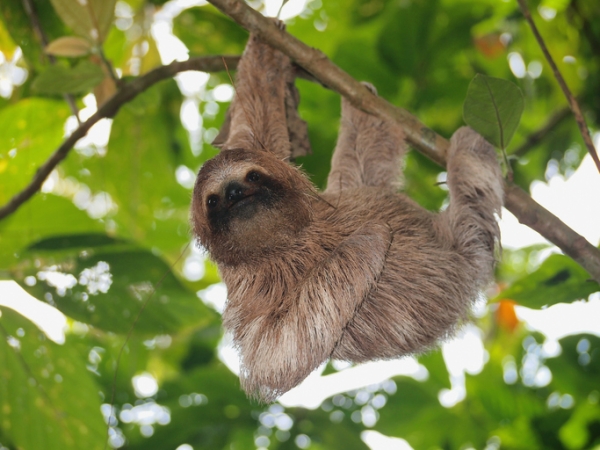
Image - Text Version
Shown is a colour photograph of an animal hanging from a branch by its feet and one arm.
The animal has long beige fur with dark brown around its face and eyes. Three of its limbs grasp the branch above its head. Its free arm is crossed casually over its chest as it looks into the treetops.
In the background, pale sky is seen through large green leaves.
Human Impacts
People living in tropical rainforests harvest fruit and medicinal plants as well as hunt animals. They also cut down trees for wood. The word for this is deforestation. Deforestation is one of the biggest threats to tropical rainforests.
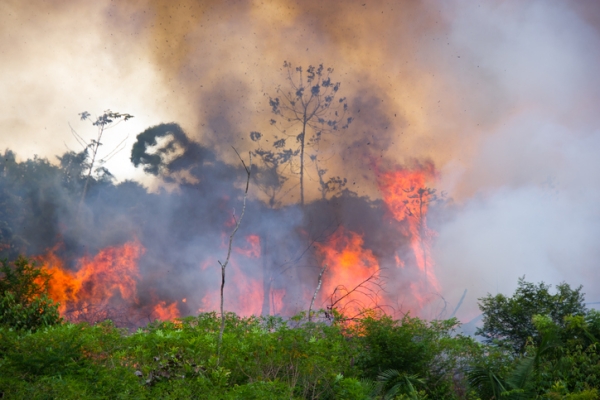
Image - Text Version
Shown is a colour photograph of a forest in flames.
There are bright orange flames among the dark outline of trees at the centre of the image. The sky above is brown and grey with thick smoke. In the foreground is a strip of bright green shrubs.
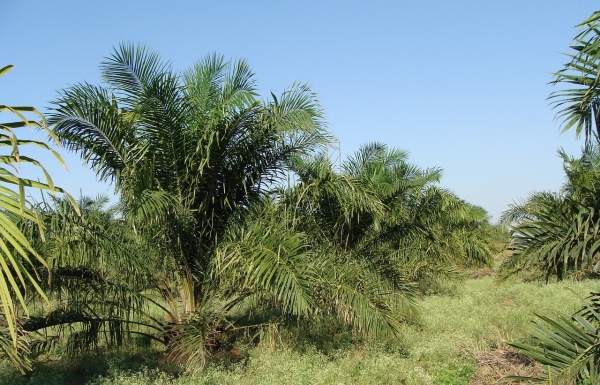
Image - Text Version
Shown is a colour photograph of a row of pam trees.
The camera is focussed on the first tree in the row. It is wide, with long, curved fronds with narrow, spiky leaves. More, similar trees stretch off to the horizon in the distance. The sky above is pale blue and the ground is covered in green grass.
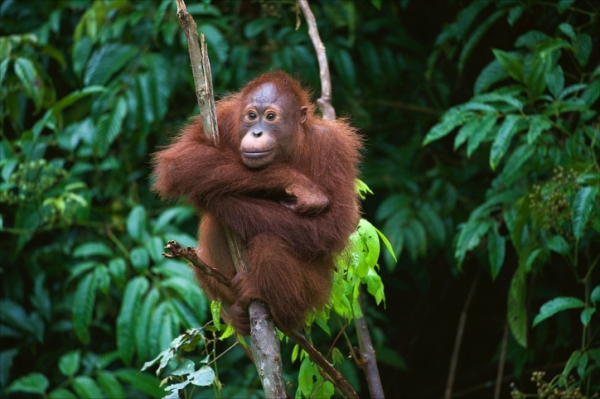
Image - Text Version
Shown is a colour photograph of an animal wrapped around a branch.
The animal has thick reddish brown fur and an expressive face with large, dark eyes. It is resting its chin on its arm and is looking off into the distance. Both its arms are wrapped around the vertical branch, as if it hugging itself. Both feet grip the branch as well.
The background is thick and dark with large green leaves.
Tropical Rainforests and Climate Change
Like other forests, tropical rainforests are important ‘carbon sinks.’ This is because plants take in carbon dioxide and release oxygen, when they undergo photosynthesis. By taking carbon dioxide from the atmosphere, the rainforest helps to slow down the effects of climate change.
Conservation
For many years, individuals, environmental organizations and others have encouraged governments to protect tropical rainforests. While there has been success in many places, deforestation is still a major problem. One way to prevent further destruction is to develop and encourage sustainable farming methods. Farmers can be taught new farming methods that require less land and less water. They can also be encouraged to maintain the forests rather than cut them down. Projects are also underway in many regions to replant trees in cleared areas. We call this process reclamation.
Learn More
Rainforests 101 | National Geographic (2019)
In this video (3:40 min.) learn about tropical and temperate rainforests, how they contribute to the global ecosystem, and the conservation efforts being done to protect these biomes.
What are tropical rainforests? (2021)
In this short video (1:39 min.) learn about the characteristics of tropical rainforests and some of the plants and animals found there.
References
Earth Observatory. (n.d.). Rainforest. NASA.
Nunez, C. (n.d.). Explore our rainforests. National Geographic.